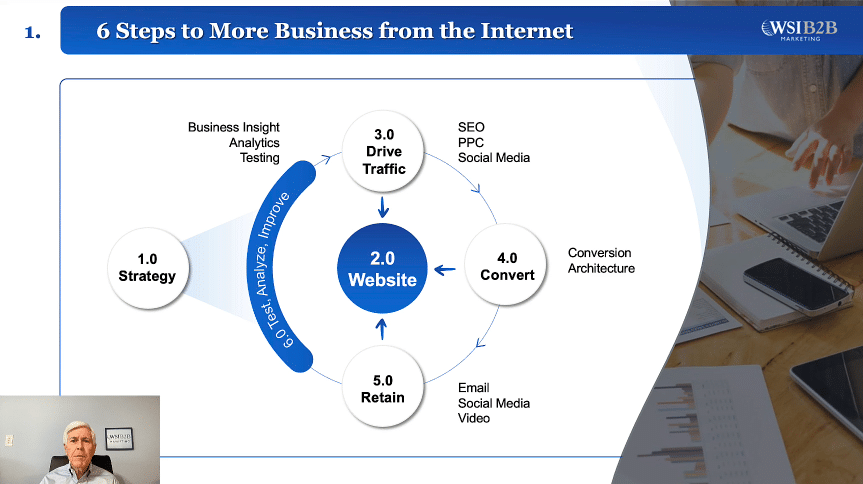Website Testing for a Competitive Advantage
January 20, 2010
The Companies Who Test Own 97% of Your Online Market
We’ve seen recent studies by AdGooRoo showing the top 3% of companies in most markets get 97% of the visitors available from search engines like Google/Yahoo/Bing (MSN). Getting this high level of traffic gives these companies a distinct competitive advantage.
If they have a positive return on investment, they can afford to spend more to market their company. This further increases their competitive advantage, and the result is a self-reinforcing cycle which makes cracking into online B2B markets increasingly more difficult for their competitors.
How to Crack Your Competitors “Code” for Success
Most companies start making changes to their ad campaigns and website. What changes will work, and what have a negligible impact? Often the choice falls to a consensus among whoever is assembled or at worst, the highest paid person in the room.
The problem is we we are making our best guesses. Even an “educated” opinion using principles of direct marketing and Internet usage, is still only a hypothesis. Getting proof frees us from guesswork and keeps the process of improvement moving in a positive direction.
If a client is torn between 2 options, we like to suggest, “Who knows, let’s just test it.” This is a excellent method to disarm skeptics and shorten frustrating brainstorming sessions you may have experienced in the past.
The top companies do exactly this.
- test their current option against a new choice
- pick the winner
- start a new test pitting the winner against new choice
Over time this process of continuous improvement takes you into the upper echelons of your market online, past the companies who aren’t testing but were either wise or lucky with their current ad campaign or website, and closer to the top 3% of your market who get 97% of the traffic.
What Should We Test?
Think “revenue” first. What on your site contributes the most to getting leads or sales?
It is a common mistake to make stylistic changes in the web copy but leave these important areas alone:
- offer or value proposition – is yours compelling and unique?
- trust level between you and the visitor – why should they stop researching and contact you right now?
- the process of making contact via the website – is it most useful to the visitor, your company, or (hopefully) both?
- followup methods and initial sales process to make the most from each lead – can you nuture leads that aren’t ready for a quote right now in a process that makes sense given your current level of staff available?
- increasing lifetime value of the customer – cross-sells or upsells. Extracting more value from each customer begins another self-reinforcing cycle where you can pay more to get a customer than a competitor. The competition is then forced to run marketing at a loss to keep up, which drains resources from their other areas of the company.
- headline on the sales copy – Changes to your headline account for 80% of improvements to results attributable to web sales copy edits. Successful B2B sales copywriters often write 100 or more headlines, then start testing.
Start with this list and leave other components alone for now. Reaching your point of diminishing returns on this list could take the next year or more depending on your amount of web traffic and can yield 3 or more digit rates of improvement.
These are often time-consuming changes, so the natural inclination is to make easier 10 minute changes to web copy, changing a font or an image which may or may not improve the site 1% at a time, while there are 10%, 20%, 50% or higher improvements available.
Locate possible improvements in these key areas by finding someone with a broad range of experience across that market and others. Within markets there is a often duplication of ideas, whether intentional or subconscious. A fresh look is vital to avoid distractions like internal politics.
Patience is key for testing
The last thing we want to do is walk away from a test thinking one was the winner when in fact the other was. Patience is crucial, and setting expectations among your company is key for ensuring you are able to complete the testing process and make solid decisions.
Your test results are based on “conversions”, which are typically sales or leads. To have a statistically-relevant amount of data, this usually takes 100 conversions or more for each event you are testing.
Some say testing only takes as little as 37 conversions, but that would only be in extreme cases where one is a wild success and the other is a complete failure. In most cases, this small of a sample size is not statistically accurate when we take into account the margin of error.
Ask your marketing team how many conversions you get in a time period, then set the other stakeholder’s expectations accordingly. We’ve seen many campaigns shipwrecked by expecting results in a week or even month when a website in a niche b2b market only gets enough web traffic to reap reliable results in 2 or 3 months.
Even if it takes longer than expected, you can be confident your results will be accurate.
How to Speed Up the Website Testing Process
Testing one vs the other (A/B testing) can take some time to run multiple tests, especially if you do not have a high-traffic website getting hundreds of leads per week or month.
An alternative is to use Taguchi or multivariate testing, which gets results from multiple tests in a much shorter time period. This is a complicated mathematical process I couldn’t explain if I tried. 🙂 Fortunately there are testing tools which implement this process and remove the need for a mathematics and computer engineering degree.
Note: The Google Website Optimizer has a multivariate test, but it is not a true Taguchi test. The result is tests using this process take substantially longer that if you used Taguchi testing.
Start Testing Today
Your toughest competition online is testing right now, and use of the Internet as a research tool for B2B buyers increases each year. Starting today with developing and implementing a testing plan is your safest option for securing your current position and achieving better results in the future.
Need More Help? Try This…
Avalanche Internet Marketing is experienced in all facets of website testing for improving lead and sales conversion rates using A/B split testing or Taguchi testing for testing multiple items with faster results.
Avalanche can also help you build strong value propositions, modify your sales copy and page layout to enhance conversions, and create follow-up processes to increase the effectiveness of your sales team.
If your business wants to achieve more with your Internet Marketing efforts and become one of the top 3% of companies in your market getting 97% of the available traffic, contact us today for a free opportunity analysis.




